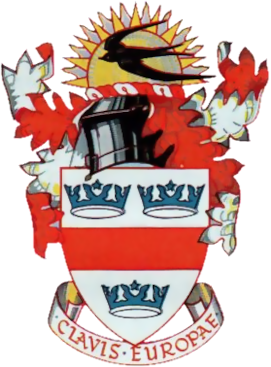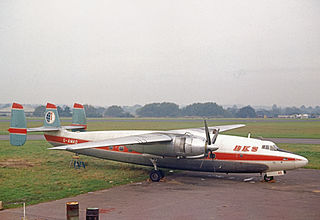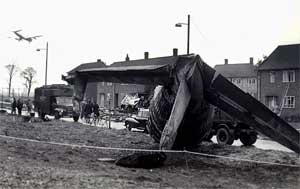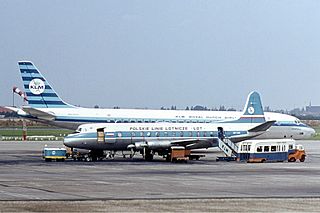
The Airspeed AS.57 Ambassador is a British twin piston-engined airliner that was designed and produced by the British aircraft manufacturer Airspeed Ltd. It was one of the first postwar airliners to be produced.

British European Airways (BEA), formally British European Airways Corporation, was a British airline which existed from 1946 until 1974.

The Vickers Vanguard was a short/medium-range turboprop airliner designed and produced by the British aircraft manufacturer Vickers-Armstrongs.

Indian Airlines was a state-owned airline in India that later became a division of Air India Limited before ultimately ceasing operations. It was based in Delhi and focused primarily on domestic routes, along with several international services to neighbouring countries in Asia and limited flights to the Middle East and Southeast Asia. It was a division of Air India Limited after the merger of eight pre-Independence domestic airlines.

In aviation, autoland describes a system that fully automates the landing procedure of an aircraft's flight, with the flight crew supervising the process. Such systems enable airliners to land in weather conditions that would otherwise be dangerous or impossible to operate in.

American Airlines Flight 157, a Douglas DC-6, departed on November 29, 1949, from New York City bound for Mexico City with 46 passengers and crew. After one engine failed in mid-flight, a series of critical mistakes by the flight crew caused the pilot to lose control of the plane during the final approach to a routine stopover at Love Field in Dallas, Texas. The airliner slid off the runway and struck a parked airplane, a hangar, and a flight school before crashing into a business across from the airport. 26 passengers and two flight attendants died. The pilot, co-pilot, flight engineer, and 15 passengers survived.

Armavia Flight 967 was a scheduled international passenger flight operated by Armavia from Zvartnots International Airport, Zvartnots in Armenia to Sochi, a Black Sea coastal resort city in Russia. On 3 May 2006, the aircraft operating the route, an Airbus A320-200, crashed into the sea while attempting a go-around following its first approach to Sochi airport; all 113 aboard were killed. The accident was the first major commercial airline crash in 2006. It was Armavia's only fatal accident during the airline's existence.

Gao International Airport, also known as Korogoussou Airport, is an airport in Gao, Mali. The airport's runway crosses through the prime meridian.

The Hawker Siddeley HS-121 Trident is a British airliner produced by Hawker Siddeley. In 1957, de Havilland proposed its DH.121 trijet design to a British European Airways (BEA) request. By 1960, de Havilland had been acquired by Hawker Siddeley. The Trident's maiden flight happened on 9 January 1962, and it was introduced on 1 April 1964, two months after its main competitor, the Boeing 727. By the end of the programme in 1978, 117 Tridents had been produced. The Trident was withdrawn from service in 1995.

Western Airlines Flight 2605, nicknamed the "Night Owl", was an international scheduled passenger flight from Los Angeles, California, to Mexico City, Mexico. On October 31, 1979, at 5:42 a.m. CST (UTC−06:00), the McDonnell Douglas DC-10 used on the flight crashed at Mexico City International Airport in fog after landing on a runway that was closed for maintenance. Of the 88 occupants on board, 72 were killed, in addition to a maintenance worker who died when the plane struck his vehicle.

On 17 February 1959, a Turkish Airlines Vickers Viscount Type 793 on an international charter flight from Esenboğa International Airport in Ankara, Turkey, to London Heathrow Airport diverted to London Gatwick Airport, United Kingdom due to heavy fog. It was carrying the Turkish prime minister and a party of government officials. The Viscount crashed in a wood 3 miles (4.8 km) from the threshold of Gatwick runway during its final approach to land in extensive fog. Five of the eight crew and nine of the 16 passengers died in the crash. The prime minister was among the ten survivors.

Cambrian Airways was an airline based in the United Kingdom which ran operations from Cardiff Airport and Liverpool John Lennon Airport between 1935 and 1974. It was incorporated into British Airways when BOAC, BEA, Cambrian and Northeast merged on 1 April 1974.

On 3 July 1968, BKS Air Transport Flight C.6845, an Airspeed Ambassador registration G-AMAD of BKS Air Transport crashed at Heathrow Airport, damaging two parked Trident airliners as it cartwheeled into the incomplete Heathrow Terminal 1, then under construction. Six of the eight people on board the Ambassador were killed, along with the eight racehorses being transported on it. The crash was blamed on the failure of a flap-operating rod due to metal fatigue, resulting in asymmetrical lift.

British European Airways Flight 411 crashed on approach to Manchester Airport after a flight from Amsterdam Schiphol International Airport on 14 March 1957 and hit a house in Wythenshawe. All on board, 20 passengers and crew, died in the crash as did two people in the house. The aircraft involved was a Vickers Viscount registration G-ALWE operated by British European Airways. The cause of the crash was metal fatigue in flaps causing loss of control.

The 1950 Heathrow BEA Vickers Viking crash occurred on 31 October 1950 when a Vickers Viking operated by British European Airways (BEA) crashed at London Airport in heavy fog. The aircraft was on a scheduled flight between Paris and London's Northolt airport and 28 of the 30 passengers and crew on board were killed.

On 5 January 1953, a Vickers Viking airliner operated by British European Airways crashed on approach to Belfast Nutts Corner Airport, Northern Ireland. The aircraft was on a domestic flight from London Northolt Airport with 31 passengers and 4 crew on board. Twenty-four of the passengers and three crew members died in the accident.

The 1962 LOT Vickers Viscount Warsaw crash occurred on 19 December 1962 when a Vickers Viscount 804, operated by LOT Polish Airlines on a flight from Brussels to Warsaw, crashed on landing. All passengers and crew died.

British Overseas Airways Corporation (BOAC) was the British state-owned airline created in 1939 by the merger of Imperial Airways and British Airways Ltd. It continued operating overseas services throughout World War II. After the passing of the Civil Aviation Act 1946, European and South American services passed to two further state-owned airlines, British European Airways (BEA) and British South American Airways (BSAA). BOAC absorbed BSAA in 1949, but BEA continued to operate British domestic and European routes for the next quarter century. The Civil Aviation Act 1971 merged BOAC and BEA, effective 31 March 1974, forming today's British Airways.


















